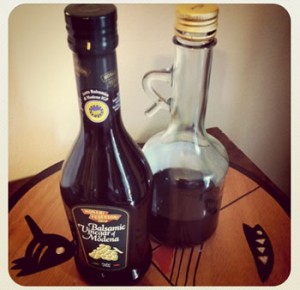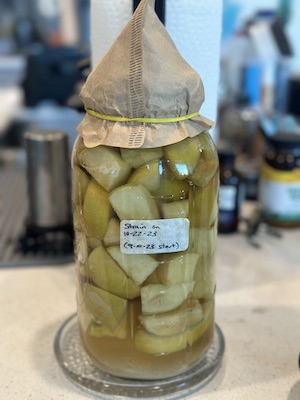Food Focus: Vinegar
Food Focus: Vinegar
 Each country develops its own variety of bottled sauces – from wine in France & Italy to rice wine in the East and malt vinegar in Britain. Soy sauce and fish sauce are essential ingredients in Oriental cuisine; and in the Middle East, pomegranate syrup is used. Once you have experimented with the various flavors, try to experiment with these amazing and tasty syrups and vinegars in various recipes. This article will briefly describe a variety of vinegars and sauces, but will focus on apple cider vinegar – it’s health benefits and uses.
Each country develops its own variety of bottled sauces – from wine in France & Italy to rice wine in the East and malt vinegar in Britain. Soy sauce and fish sauce are essential ingredients in Oriental cuisine; and in the Middle East, pomegranate syrup is used. Once you have experimented with the various flavors, try to experiment with these amazing and tasty syrups and vinegars in various recipes. This article will briefly describe a variety of vinegars and sauces, but will focus on apple cider vinegar – it’s health benefits and uses.
Storage
Vinegars and other bottled sauces are usually highly acidic or salty. Since salt and acid are natural preservatives, they should last for at least six months or longer. They should be stored in a cool, dark cupboard, away from heat. After a year or so in storage, they will probably lose their subtle flavor and have a sharper taste.
Food pastes do not store as well and, once opened, they should be stored in the refrigerator (covered in a thin layer of oil). I always recommend glass storage containers.
Wine Vinegars – The quality of wine vinegars vary tremendously. The best wine vinegars are made by the Old Orleans method. Barrels are filled with wine and vinegar along with starter vinegar. With time, microorganisms convert the wine into acetic acid. Once the process has been completed, some of the vinegar is removed and new wine is added to begin the process all over again.
Balsamic Vinegar – Balsamic vinegars have a wonderful, sweet & nutty rich taste. It is made from the juice of Trebbiano grapes (one of the world’s most widely grown white wine grape varieties.) The grapes are simmered and thickened before the fermentation process, which is quite lengthy, begins. First, it ferments in a huge barrel (chestnut or oak). As the liquid evaporates and concentrates, it is moved into smaller and smaller barrels. The process lasts from a minimum of 4-5 years to 40 or more years, by which time it is reduced to thick syrup. The older the balsamic vinegar, the less you will need to provide incredible and subtle flavors to your cuisine. A few drops will go a long way to releasing the flavor of your food. It can be sprinkled lightly over food, enhances sauces & dressings, Add it towards the end of the cooking process and never let it boil. It can be added to strawberries and other fruits for a yummy twist ii fruit salad.
Sherry Vinegar – Sherry vinegar comes from Jerez, Spain. It is a gourmet wine made from sherry. It is rich, aromatic and sweet and can be used as a seasoning in Spanish dishes, on salads, in soups, or to enrich sauces.
Perry Vinegar – Perry vinegar is made from pears. It is mild and should have the faint smell of apples. It can be used the same way cider vinegar is used.
Rice Vinegar – Rice vinegar is made from rice wine. It is sweet and has a faint yellow color. It has a mild, delicate flavor and can be used in dressings, for pickling, or to season the rice for sushi. Brown rice vinegar is darker in color and has a more pronounce flavor.
Black Rice Vinegar – Black rice vinegar comes from China. It is very dark and inky looking. It is thicker than most vinegar and has a sharp, rich, spicy fragrance. It is reminiscent of balsamic vinegar. It is used for braising, enriching sauces and as a dipping sauce.
Fruit-Flavored Vinegars – Fruit vinegars are made by macerating fruit in vinegar and letting it sit over a period of days before straining it through a cheesecloth-lined sieve. Raspberries, currants, blackberries and blueberries make excellent fruit vinegars. They can be used in long summer drinks (added to ice tea) or fine vinaigrettes.
Herb-Flavored Vinegars – Vinegar can be flavored with practically anything that you wish. It is made by pushing a few large sprigs of herbs (either a single type or a combination) into the bottle of vinegar. Use a good quality white wine vinegar, rice vinegar or cider vinegar. Then leave it on a sunny, warm windowsill for a week or longer. If the green sprig begins to fade color and starts looking tired, strain the vinegar and rebottle it.
Chili Vinegar – Chili vinegar can be as strong as you wish it to be. Add one or two chilies for a mild, spicy flavor; or add a handful for a chili explosion. You can also use garlic or other bruised spices in the mixture. Follow the method outlines above.
(Apple) Cider Vinegar – Cider vinegar has a sweet and gentle taste and low acidity. When it is good, it has a sweet, faint smell of apples. It is mild and often used for pickling, for flavoring, with herbs, and for dressings over salad. It can be used as a drink, lightly sweetened, and topped with mineral water.
Crushing organically grown apples and storing them in wooden barrels make organic apple cider. Over time, the fermentation causes a web-like bacterial foamy substance to grow over the fermented material. This substance, which is called mother, can be used to add to other apple cider vinegar to speed up its maturity or to initiate the fermentation process of more apple cider vinegar. The natural vinegars that have the mother contain minerals and enzymes that are not found in commercially distilled vinegars (due to over-heating, over-processing, and filtration). Natural apple cider vinegar has an ideal acidity level (pH) of 5-7.
Apple Cider Vinegar, with an ideal acidity (pH) level of 5 to 7, is a natural probiotic health drink.
- It is important to utilize natural organic apple cider vinegar for many reasons:
- It contains vital minerals and trace elements (potassium, magnesium, phosphorous, chlorine, sodium, sulfur, copper, iron, silicon & fluorine) – all needed for a healthy body.
- It is a natural probiotic.
- It has been used to treat some chronic conditions, eliminating the need for dangerous medications.
It has been known to:
- Reduce sinus infections and sore throats
- Balance high cholesterol
- Cure skin conditions such as acne
- Protect against food poisoning
- Fight allergies in both humans and animals
- Prevent muscle fatigue after exercise
- Strengthen the immune system
- Increase stamina
- Increase metabolism – which promotes weight loss
- Improve digestion and cure constipation
- Alleviate symptoms of arthritis and gout
- Prevents bladder stones and urinary tract infections
- Has been found to be an effective treatment for yeast infections.
General Home Remedies:
Daily maintenance, Weight Loss & pH balancing – 2 teaspoons of ACV in a glass of water, three times per day, before meals.
Halitosis – Add 2 teaspoons of ACV in to a cup of water and gargle with the mixture for 10 seconds at a time. Spit. Repeat.
Body Odor –
- Under arms – wipe ACV under armpit with a cotton ball every morning.
- Feet – soak feet in a pan filled with water containing 1/3 cup of ACV for 15 minutes each week.
Acne – Apply a solution of ACV and water (2 tablespoons per 8 oz water) with a cotton ball several times a day.
As you can see, there are many types of vinegar as well as many uses for vinegar. Explore, try something new, and enjoy the different flavors and textures. Bon Appétit!
Sources:
• Sophie Grigson’s Ingredients Book; Sophie Grigson, Mitchell Beazley, 1993
• http://foodmatters.tv/



